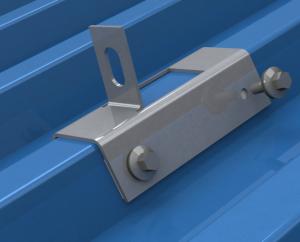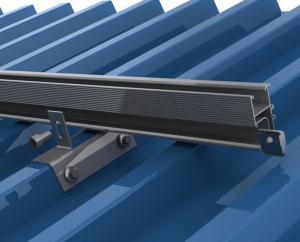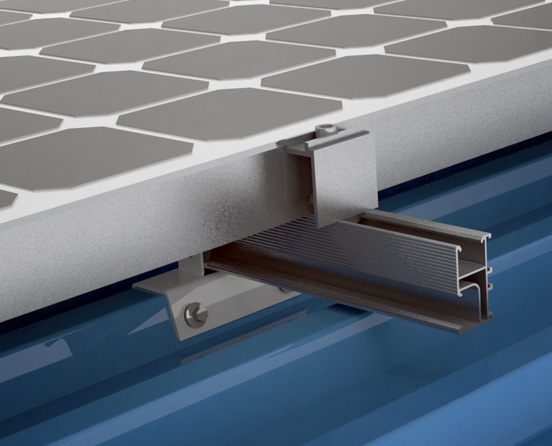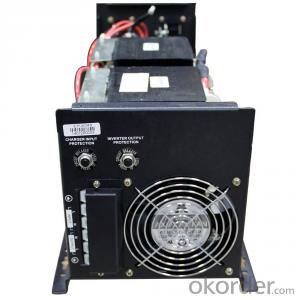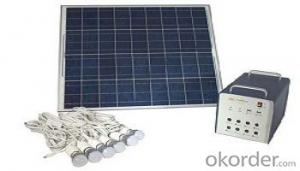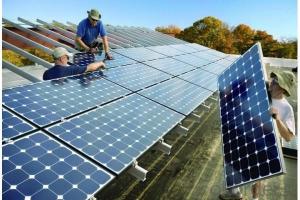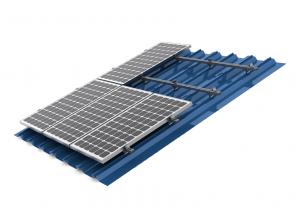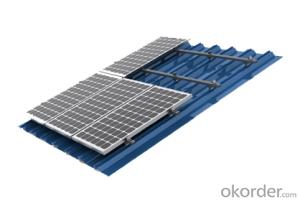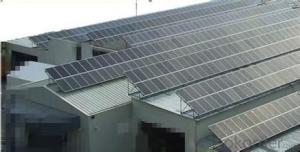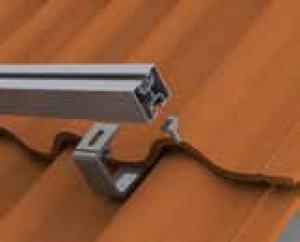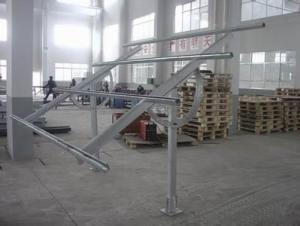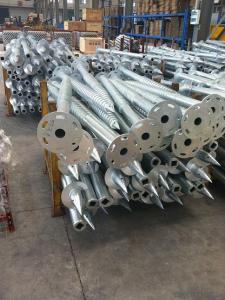Solar Energy Systems Swarthmore - Solar Mounting Metal Sheet Roof System
- Loading Port:
- China Main Port
- Payment Terms:
- TT OR LC
- Min Order Qty:
- -
- Supply Capability:
- -
OKorder Service Pledge
OKorder Financial Service
You Might Also Like
Product Features
• Less piece of components and easy for installation.
• Design speical clamp matching to the metal sheet shape and specification.
• Use super quality Al-alloy and stainless steel for components.
• Wide range of product line .
Technical Data
Installation site Metal sheet roof
Slope of roof Client requirement
Module specification Frame / frameless module, crystalline/thin film module
Installation type Parallel to the roof
Module arrangement Portrait Landscape
Module area square Client requirement
Module area position Client requirement
Roof structure Client requirement
Loading section Al 6063 T5
Small pieces Stainless steel, Al6063 T5
- Q: How do solar energy systems impact the demand for fossil fuels?
- Solar energy systems have a significant impact on the demand for fossil fuels as they provide a clean and renewable source of energy. By harnessing the power of the sun, solar energy systems reduce the need for traditional fossil fuel-based electricity generation. As a result, the demand for fossil fuels decreases, leading to reduced carbon emissions and a more sustainable energy future.
- Q: What is the impact of dust and dirt on the performance of solar panels?
- Dust and dirt can significantly impact the performance of solar panels. When accumulated on the surface of the panels, they can reduce the amount of sunlight reaching the photovoltaic cells, thereby decreasing the overall energy production. Dust and dirt particles can also create shading, which further reduces the panel's efficiency. Regular cleaning and maintenance are necessary to ensure optimal performance and maximize the energy output of solar panels.
- Q: How do solar energy systems impact energy efficiency measures?
- Solar energy systems have a positive impact on energy efficiency measures by reducing the overall energy consumption of a building or facility. By harnessing the power of the sun, solar panels generate clean and renewable electricity, which can offset the need for traditional energy sources. This not only lowers energy costs but also reduces greenhouse gas emissions. Furthermore, solar energy systems can integrate with energy-efficient technologies such as LED lighting or smart thermostats, maximizing the overall efficiency and sustainability of a building.
- Q: What is the role of grounding systems in a solar energy system?
- The role of grounding systems in a solar energy system is to ensure safety and protect the system and its users from electrical faults and lightning strikes. Grounding refers to the connection of electrical equipment and components to the Earth's surface, creating a low-impedance path for electrical faults to flow, thus preventing the buildup of excessive voltages that could pose a risk to people and equipment. In a solar energy system, grounding serves several important purposes. Firstly, it provides protection against electrical shock by redirecting any fault currents into the ground, minimizing the potential for injury. This is crucial as solar panels and inverters are exposed to sunlight and could be touched by people during maintenance or repairs. Secondly, grounding helps to dissipate static electricity that might accumulate in the system, particularly in panels and mounting structures. Static electricity can cause damage to sensitive electronics and may even lead to fires or explosions if not properly controlled. By grounding these components, any static charges are safely discharged into the ground. Moreover, grounding systems play a vital role in safeguarding the solar energy system against lightning strikes. Lightning carries enormous amounts of electrical energy, and without proper grounding, it can cause severe damage to the system. By providing a low-resistance path for lightning to follow, grounding systems channel the electrical energy safely into the ground, protecting the solar panels, inverters, and other equipment from damage. Lastly, grounding systems help to maintain a stable electrical reference point for the system. This is important for accurate monitoring, control, and efficient operation of the solar energy system. Grounding helps to minimize electromagnetic interference (EMI) and noise that can affect the performance of sensitive electronic components, ensuring optimal functioning of the system. In summary, the role of grounding systems in a solar energy system is to ensure safety by protecting against electrical shocks, dissipating static electricity, and safeguarding against lightning strikes. Additionally, grounding systems maintain a stable electrical reference point, promoting efficient operation and reducing the risk of equipment damage.
- Q: Are there any risks of electrical surges or voltage fluctuations with solar energy systems?
- Yes, there are potential risks of electrical surges or voltage fluctuations with solar energy systems. These risks can be caused by factors such as lightning strikes, grid disturbances, or faults in the solar panels or inverters. However, modern solar energy systems are equipped with protective measures, such as surge protectors and voltage regulators, to minimize these risks and ensure the safe and efficient operation of the system. Regular maintenance and inspections are also important to identify and address any potential issues that may arise.
- Q: Can solar energy systems be used in areas with limited access to solar charge controllers?
- Yes, solar energy systems can still be used in areas with limited access to solar charge controllers. While solar charge controllers are important for regulating the flow of electricity from the solar panels to the batteries, there are alternative methods available. For example, manual charge controllers or simple voltage regulators can be used to protect the batteries from overcharging. Additionally, it is possible to design solar energy systems with smaller battery banks or use direct power consumption without the need for batteries, which eliminates the requirement for charge controllers altogether. Therefore, even in areas with limited access to solar charge controllers, solar energy systems can still be effectively utilized.
- Q: Can solar energy be used for large-scale power generation?
- Yes, solar energy can be used for large-scale power generation. With advancements in technology and decreasing costs, large-scale solar power plants or solar farms can now efficiently harness sunlight to generate electricity on a significant scale. These plants typically consist of thousands of solar panels that convert sunlight into electricity, which can then be fed into the power grid to meet the energy demands of a vast number of households and industries.
- Q: Can a solar energy system be installed in areas with extreme weather conditions?
- Indeed, solar energy systems have the capability of being installed in regions that experience severe weather conditions. These systems are specifically constructed to endure a broad spectrum of weather phenomena, including extreme cold, heat, wind, rain, and snow. In fact, solar panels are frequently utilized in diverse areas with intense weather conditions, such as deserts, arctic regions, and coastal zones. To guarantee the sturdiness and effectiveness of the system, solar panels are constructed using top-notch materials that possess the ability to withstand adverse weather conditions. They are designed to be resistant to impact and undergo rigorous testing to ensure they can endure hail, strong winds, and heavy snow loads. Furthermore, the frames and mounting systems employed for solar panels are engineered to provide stability and protection against extreme weather events. Even in frigid weather conditions, solar energy systems can still function efficiently, although their performance may be slightly affected by the lower temperatures. Solar panels are specifically designed to absorb sunlight, enabling them to generate electricity even under low-light circumstances. In snowy areas, solar panels are typically installed at an angle to facilitate the shedding of snow and prevent accumulation that could reduce their efficiency. In regions with scorching heat, solar energy systems can still operate effectively, albeit with a slight reduction in panel efficiency due to elevated temperatures. Nevertheless, contemporary solar panels are equipped with heat dissipation features to minimize any performance losses caused by high temperatures. In summary, solar energy systems possess remarkable adaptability and can be successfully installed in areas that experience extreme weather conditions. They are designed to withstand a wide range of weather elements, ensuring the generation of clean and renewable energy persists even in challenging environments.
- Q: Can solar energy systems be used for indoor lighting?
- Yes, solar energy systems can be used for indoor lighting. Solar panels can be installed on rooftops or in outdoor areas to capture sunlight, which is then converted into electricity and stored in batteries. This stored energy can be used to power lights indoors, providing a sustainable and cost-effective lighting solution.
- Q: Can solar energy be used for heating?
- Yes, solar energy can be used for heating. Solar thermal systems can collect and convert sunlight into heat energy, which can then be used for heating water, homes, or other applications.
Send your message to us
Solar Energy Systems Swarthmore - Solar Mounting Metal Sheet Roof System
- Loading Port:
- China Main Port
- Payment Terms:
- TT OR LC
- Min Order Qty:
- -
- Supply Capability:
- -
OKorder Service Pledge
OKorder Financial Service
Similar products
Hot products
Hot Searches
Related keywords

